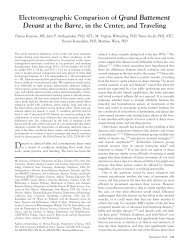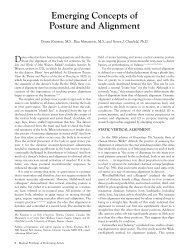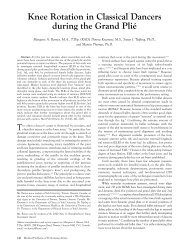And the Dance Goes On - Conditioning-with-Imagery
And the Dance Goes On - Conditioning-with-Imagery
And the Dance Goes On - Conditioning-with-Imagery
You also want an ePaper? Increase the reach of your titles
YUMPU automatically turns print PDFs into web optimized ePapers that Google loves.
110 Journal of <strong>Dance</strong> Medicine & Science Volume 5, Number 4 2001<br />
surgery63-69 and after athletic injury.<br />
24 Similarly, hardiness has been<br />
found to be negatively associated<br />
<strong>with</strong> total mood disturbance in relation<br />
to athletic injury. 45 Observation<br />
reveals that dancers exhibit hardiness<br />
in relation to overuse injuries<br />
in that <strong>the</strong>y often endure pain and<br />
discomfort in order to rehearse and<br />
perform. The following quotation<br />
from two experts in dance medicine<br />
and science (one a former dancer)<br />
alludes to this personality trait:<br />
To survive and ascend, a dancer<br />
must be self-analytical and selfcritical<br />
virtually to a fault. For<br />
dancers, dance is more than an<br />
art; it is an all-consuming<br />
lifestyle. The aes<strong>the</strong>tic, <strong>the</strong> technique,<br />
<strong>the</strong> teachers, and perhaps<br />
most importantly, <strong>the</strong> dancer<br />
must constantly push to exceed,<br />
to overcome, to persist and to<br />
persevere. The love of dance and<br />
desire to dance are intrinsic to<br />
dancers of all levels and talent.<br />
Many have sacrificed so much<br />
just to have those few moments<br />
of pure movement where <strong>the</strong><br />
physical price was no measure of<br />
<strong>the</strong> artistic reward. 68<br />
The image one has of oneself, or<br />
identity, is often defined by one’s<br />
work. For dancers, <strong>the</strong>ir work is <strong>the</strong>ir<br />
dancing: it is a way of life that defines<br />
who <strong>the</strong> dancer is. Therefore, any barrier<br />
to self-expression and movement<br />
may be a threat to a dancer’s identity.<br />
Identity is <strong>the</strong> most examined person<br />
factor in recovery from athletic<br />
injury. 46 The research suggests that <strong>the</strong><br />
more narrowly defined <strong>the</strong> sense of<br />
self, <strong>the</strong> more threatened <strong>the</strong> athlete<br />
will be by any challenge to identity.<br />
In <strong>the</strong> case of injury, <strong>the</strong> more an<br />
athlete’s self-identity is linked to his<br />
or her role as athlete, <strong>the</strong> more likely<br />
reactions to injury will be negative<br />
(e.g., feelings of anxiety, depression,<br />
or hopelessness). 31,33 The fundamental<br />
loss of self that accompanies<br />
chronic illness or injury69,70 or athletic<br />
injury, 24,71 and <strong>the</strong> context <strong>with</strong>in<br />
which this happens, has been well established<br />
in <strong>the</strong> sport sociology research.<br />
71,72 Moreover, <strong>the</strong> concept “re-<br />
storing <strong>the</strong> self ” after injury is an<br />
emergent <strong>the</strong>me in <strong>the</strong> psychology<br />
and sociology literatures 24,71 that has<br />
implications for rehabilitation and<br />
treatment. These implications will be<br />
discussed in a later section.<br />
Shaffer found that prior experience<br />
<strong>with</strong> successful rehabilitation<br />
had a positive impact on assessments<br />
of ability to manage subsequent<br />
injury. 73 This is consistent<br />
<strong>with</strong> social learning <strong>the</strong>ory and research,<br />
which indicates that self-efficacy<br />
(<strong>the</strong> belief that one can accomplish<br />
a particular task) is an<br />
important mediator of behavior.<br />
Psychosocial Issues<br />
Treatment<br />
A few trends have been identified<br />
<strong>with</strong> respect to <strong>the</strong> medical and psychosocial<br />
issues of injury reporting<br />
and treatment. Pedersen and<br />
Wilmerding suggested that most<br />
foot injuries were not reported to<br />
or treated by a physician. 52 Similarly,<br />
Kerr and associates found that only<br />
20% of <strong>the</strong> injuries identified by<br />
university dancers were reported to<br />
a physician. 54 In <strong>the</strong> latter study, <strong>the</strong><br />
dancers indicated that <strong>the</strong>y did not<br />
feel comfortable seeing a physician<br />
because <strong>the</strong>y perceived that <strong>the</strong>ir<br />
situations and injuries would not be<br />
understood, and that <strong>the</strong>y would be<br />
told to stop dancing regardless of<br />
<strong>the</strong> severity of <strong>the</strong> injury. In general,<br />
<strong>the</strong>re was a lack of confidence in<br />
medical practitioners.<br />
Ryan and Stephens in <strong>the</strong>ir 1988<br />
book wrote that:<br />
until very recently <strong>the</strong>re was<br />
little information about <strong>the</strong><br />
causes, nature and appropriate<br />
treatment of dancers’ injuries<br />
available to physicians. As a consequence,<br />
dancers may have had<br />
difficulty in finding physicians<br />
who had good understanding of<br />
<strong>the</strong>ir situation and <strong>the</strong>ir particular<br />
problems. 68<br />
They indicate that <strong>the</strong> same was true<br />
years ago of athletes and physicians.<br />
“Both have learned from cultivating<br />
<strong>the</strong>se relationships, and <strong>the</strong> same<br />
thing is possible for dancers.” 68<br />
Clearly, <strong>the</strong> lack of information and<br />
understanding about <strong>the</strong> nature of<br />
both <strong>the</strong> physical and psychosocial<br />
impact of dance injuries has affected<br />
<strong>the</strong> treatment available to dancers.<br />
Most dancers have not been afforded<br />
<strong>the</strong> luxury of a practitioner<br />
who once danced or who specializes<br />
in dance injuries. Consequently, <strong>the</strong><br />
field of dance medicine and science<br />
serves a vital educational function<br />
in <strong>the</strong> lives of dancers and those who<br />
treat <strong>the</strong>m. As Trepman points out,<br />
“<strong>the</strong> primary goal of <strong>the</strong> emerging<br />
field of dance medicine and science<br />
is improved prevention, diagnosis,<br />
treatment, and rehabilitation of<br />
dance injuries.” 74<br />
From a psychological perspective,<br />
it is important for dancers to be understood<br />
by <strong>the</strong>ir practitioners, as<br />
dancers want to feel comfortable<br />
knowing that <strong>the</strong>ir medical personnel<br />
and teachers understand <strong>the</strong>ir<br />
injury, lifestyle, and <strong>the</strong> implications<br />
of <strong>the</strong> injury for <strong>the</strong>ir participation<br />
in dance. They do not want<br />
to be told to stop dancing, and <strong>the</strong>y<br />
want <strong>the</strong> practitioner to understand<br />
that, unlike some athletes, dancers<br />
do not have an “off season.” <strong>Dance</strong>rs<br />
often rehearse for large shows or<br />
a series of shows in a concentrated<br />
period, so that a two-week break<br />
from practice, which may seem negligible<br />
to <strong>the</strong> medical person, may<br />
well seem catastrophic to <strong>the</strong> dancer.<br />
Reporting and treatment of injuries,<br />
or lack <strong>the</strong>reof, is very much tied to<br />
psychological and psychosocial issues<br />
such as personal beliefs, perceived<br />
risks, available social support,<br />
and <strong>the</strong> culture of tolerance. Assessment<br />
and treatment of injuries<br />
should include a careful history and<br />
consideration of intrinsic factors,<br />
such as “associated illness, nutrition,<br />
cultural de-conditioning, and psychosocial<br />
stress.” 75<br />
Stress, Injury, and Social Support<br />
A relationship has been demonstrated<br />
between increased stress and<br />
injury in sport 19,76-79 and dance. 7,13<br />
Evidence from research on dance<br />
injury suggests that negative life<br />
stress (events such as a difficult re-





